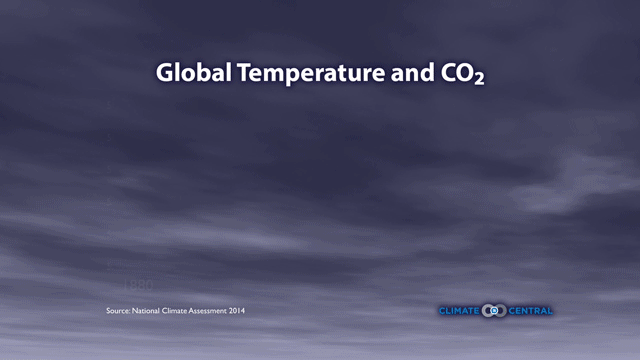News•September 9, 2014
Another Year, Another Record High for Greenhouse Gases

By Brian Kahn
The numbers are in and in case there was any doubt, 2013 was another recordsetting year for greenhouse gases. The atmosphere is home to more warming gases than at any other point since industrialization. And carbon dioxide, the main culprit, is causing oceans to acidify at a rate unseen in at least 300 million years.
Credit: Climate Central

The news comes courtesy of the World Meteorological Organization’s annual Greenhouse Gas Bulletin, released Tuesday. The report tracks carbon dioxide, methane, nitrous oxide and other greenhouse gases at dozens of monitoring stations around the world and provides a snapshot of how humans are changing the planet.
Greenhouse gases from human sources have contributed to a 1.8°F rise in the global average temperature since the start of the Industrial Revolution as well as a host of other changes from rising seas to shrinking sea ice. Emissions have also contributed to a rise in the acidity of the ocean, which could have long-lasting consequences for marine ecosystems and food security.
Of those greenhouse gases, CO2 is the grandaddy. Since 1990, it has accounted for 80 percent of the earth’s increased heat-trapping ability. In 2013, the concentration of CO2 in the atmosphere crossed 400 parts per million (ppm) for the first time in human history. It also crossed that threshold again earlier this year, staying there for three months.SEE MOREMap Shows When Summer Heat Peaks in Your Town
New CO2 Milestone: 3 Months Above 400 PPM
5 Graphics That Show U.S. Climate Change Costs
Using an array of monitoring stations and averaged over all of 2013, CO2 levels were about 396 ppm. That represents a 42 percent increase over pre-industrial times when CO2 stood at 278 ppm.
Methane has increased at an even more notable clip, rising to 153 percent over pre-industrial levels while nitrous oxide rose 21 percent over that period. Both account for a much smaller portion of greenhouse gases that humans have added to the atmosphere, but they’re much more potent than CO2.
“We know without any doubt that our climate is changing and our weather is becoming more extreme due to human activities such as the burning of fossil fuels,” WMO Secretary-General Michel Jarraud said in a press release.
One change the new report looks at in depth is ocean acidification. Oceans are a particularly important sink for CO2, taking up a quarter of all human emissions. Put another way, the report says that oceans take up about 9 lbs. of CO2 per day per person, even on weekends. No matter how it’s calculated, oceans are keeping a substantial chunk of CO2 out of the atmosphere.
However, that’s coming with the price of ocean acidification. The report says ocean acidification is happening at a rate unheard of in at least 300 million years, and just as alarming, that rate is projected to accelerate until at least mid-century.
The Keeling Curve, whichs hows the rise of CO2 since the late 1950s as measured at Mauna Loa Observatory.
Credit: NOAA

Acidification has wide-ranging consequences including wreaking havoc on coral reef ecosystems, weakening the shells of shellfish, negatively affecting fisheries and generally altering the ocean food chain.
“The Greenhouse Gas Bulletin shows that, far from falling, the concentration of carbon dioxide in the atmosphere actually increased last year at the fastest rate for nearly 30 years,” Jarraud said. “We must reverse this trend by cutting emissions of CO2 and other greenhouse gases across the board. We are running out of time.”
Jarraud’s comments and the report come a few weeks ahead of a series of high profile climate events in New York, including the UN Climate Summit, which will bring together a number of world leaders, including President Obama and U.K. Prime Minister David Cameron. While no international agreements for dealing with climate change are expected to come from the Summit, it is expected to pave the way for a future agreement sometime in 2015.
Until then – and even after – greenhouse gas emissions will continue rising.
You May Also Like:
New York to Become a Hub of Climate Hubbub
Coal Plants Lock in 300 Billion Tons of CO2 Emissions
A Tale of Two Cities: Miami, New York and Life on the Edge
Climate Change Ups Odds of a Southwest Megadrought
